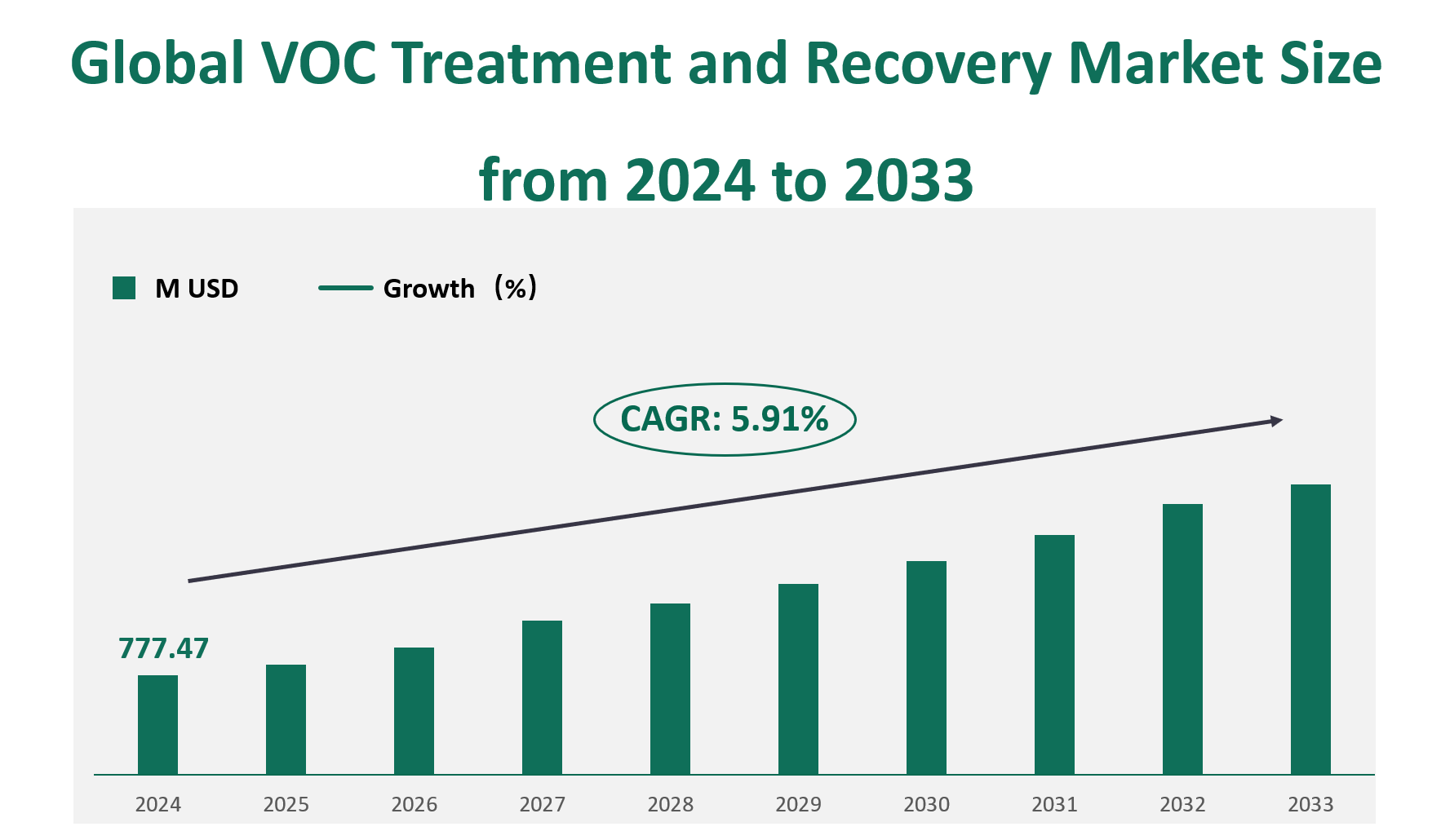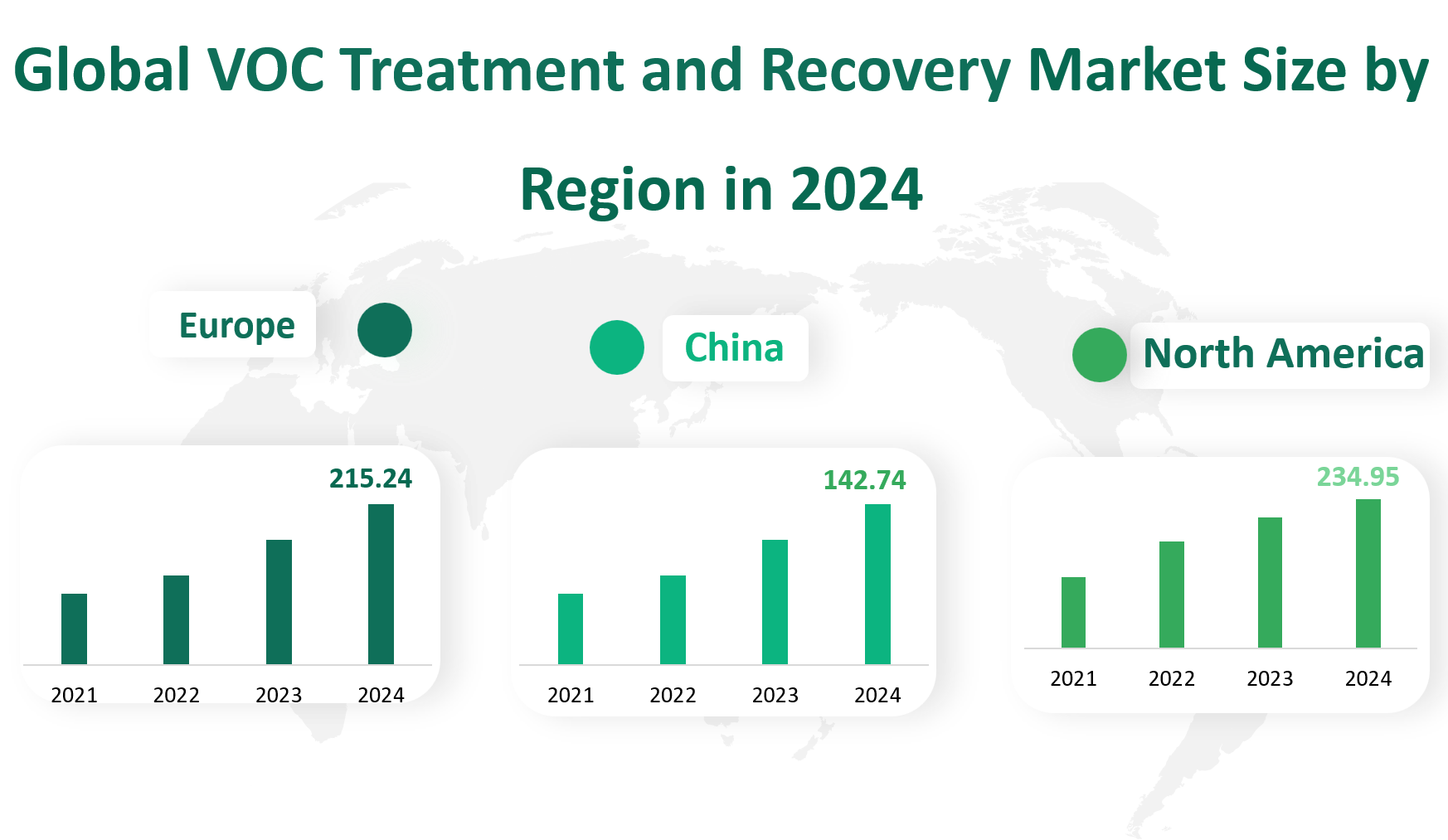1. Global VOC Treatment and Recovery Market Insight Analysis
The global VOC (Volatile Organic Compounds) Treatment and Recovery market is projected to reach a value of 777.47 million USD by 2024, with a Compound Annual Growth Rate (CAGR) of 5.91% from 2024 to 2033.
Volatile Organic Compounds (VOCs) are organic chemicals that have a high vapor pressure at room temperature. They are emitted from various industrial processes and consumer products, contributing to air pollution and posing health risks. VOCs are significant precursors to the formation of ground-level ozone and particulate matter (PM2.5), which are harmful to human health and the environment. The treatment and recovery of VOCs involve technologies and processes designed to reduce or eliminate these emissions. This includes methods such as thermal oxidation, catalytic oxidation, adsorption, and photo-oxidation.
These technologies aim to convert VOCs into less harmful substances or recover them for reuse, thereby minimizing environmental impact and improving air quality. The importance of VOC treatment and recovery is underscored by the increasing regulatory requirements and the push for sustainable industrial practices. As industries strive to meet environmental standards and reduce their carbon footprint, the demand for effective VOC treatment and recovery solutions continues to grow.
Figure Global VOC Treatment and Recovery Market Size (M USD) and CAGR (2024-2033)

2. Driving and Limiting Factors of VOC Treatment and Recovery Market Growth
The growth of the VOC Treatment and Recovery market is driven by several key factors. First, increasing environmental regulations across the globe are compelling industries to adopt more effective VOC management solutions. Governments are implementing stricter policies to reduce air pollution and protect public health, which has led to a surge in demand for advanced treatment technologies.
Second, emerging economies such as China, India, and Brazil are experiencing rapid industrialization, resulting in higher emissions of VOCs. These countries are investing heavily in pollution control technologies to mitigate environmental damage. Third, technological advancements in VOC treatment methods are making it easier and more cost-effective for industries to comply with environmental standards. Innovations in thermal and catalytic oxidation, as well as adsorption technologies, are driving market growth.
Finally, growing awareness among industries about the benefits of VOC recovery, such as cost savings and resource conservation, is also contributing to the market expansion.
One significant limiting factor is the high initial investment cost required for advanced treatment technologies. Many small and medium-sized enterprises (SMEs) may find it difficult to afford these systems, thus limiting market penetration.
Another challenge is the lack of uniform regulations across different regions, which can create confusion and increase compliance costs for multinational companies. Additionally, technical barriers such as the need for specialized expertise to operate and maintain VOC treatment systems can hinder market growth. Finally, economic fluctuations and policy changes can impact the market negatively, especially in regions where government support is crucial for the adoption of new technologies.
3. Technology Innovation and Corporate Mergers and Acquisitions in VOC Treatment and Recovery Market
The VOC Treatment and Recovery market is witnessing significant technological advancements aimed at improving efficiency and reducing costs. Thermal destruction methods, such as Regenerative Thermal Oxidation (RTO) and Recuperative Thermal Oxidation, are becoming more popular due to their high efficiency and energy recovery capabilities.
Catalytic oxidation is another area of innovation, with new catalysts being developed to enhance VOC conversion rates while reducing energy consumption. Photocatalytic oxidation is also gaining attention for its ability to decompose VOCs under normal temperature conditions, making it a more sustainable option. Additionally, biological methods and membrane separation technologies are being explored for their potential in treating low-concentration VOC emissions. These technological innovations are crucial for meeting the increasing demand for effective and environmentally friendly VOC treatment solutions.
Corporate activity in the VOC Treatment and Recovery market is characterized by strategic mergers and acquisitions aimed at expanding market share and enhancing technological capabilities. Major players such as CECO Environmental Corp, Durr Group, and CMI Group are actively involved in consolidating their positions through strategic partnerships and acquisitions. For example, CECO Environmental Corp has been focusing on expanding its product portfolio to include a wider range of VOC treatment solutions.
Similarly, Durr Group has been investing in R&D to develop more efficient oxidation technologies. These corporate activities are not only driving market growth but also fostering innovation and competition, which ultimately benefits end-users by providing more effective and cost-efficient solutions.
4. Global VOC Treatment and Recovery Market Size by Type
RTO systems use high temperatures to oxidize and destroy VOCs in industrial exhaust gases. They are highly efficient and energy-saving, utilizing ceramic media to recover and reuse heat. The market value for RTO is projected to reach $96.8 million by 2024. This technology is particularly popular in industries with high VOC emissions due to its effectiveness and energy efficiency.
Similar to RTO, recuperative thermal oxidizers use heat to break down VOCs. However, they differ in their heat recovery mechanism, which typically involves a heat exchanger to recover thermal energy. The market value for recuperative thermal oxidizers is expected to be $125.8 million by 2024.
Catalytic oxidizers use catalysts to lower the temperature required for VOC destruction, making the process more energy-efficient. They are suitable for applications with lower VOC concentrations. The market value for catalytic oxidizers is forecasted to be $256.72 million by 2024.
Photo-oxidation involves the use of ultraviolet light to break down VOCs into less harmful substances. This method is effective for treating low concentrations of VOCs and is environmentally friendly. The market value for photo-oxidation is projected to be $31.49 million by 2024.
Activated carbon adsorption is a physical process where VOCs are captured and held on the surface of activated carbon. This method is versatile and can be used for a wide range of VOCs. The market value for activated carbon adsorption is expected to reach $162.34 million by 2024.
Table Global VOC Treatment and Recovery Market Size by Type in 2024
Market Size (M USD) 2024 | |
Regenerative Thermal Oxidation | 96.80 |
Recuperative Thermal Oxidation | 125.80 |
Catalytic Oxidation | 256.72 |
Photo-oxidation | 31.49 |
Adsorption by Activated Carbon | 162.34 |
Others | 104.34 |
5. Global VOC Treatment and Recovery Market Size by Application
The applications of VOC Treatment and Recovery technologies span across various industries, each with unique requirements and challenges. The major applications include:
Basic Chemical Raw Materials application involves the treatment of VOCs emitted during the production and processing of basic chemical raw materials. These emissions are often complex and require robust treatment solutions. The market value for this application is projected to be $173.45 million by 2024.
The production of synthetic materials such as plastics and polymers generates VOCs that need to be treated to prevent environmental contamination. The market value for synthetic material applications is expected to be $77.44 million by 2024.
The plastic and rubber industries are significant sources of VOC emissions, particularly during manufacturing processes. Effective treatment solutions are essential to mitigate environmental impact. The market value for plastic and rubber applications is forecasted to be $99.21 million by 2024.
The petroleum industry, including oil refining and petrochemical production, is a major emitter of VOCs. Treatment and recovery solutions are critical for compliance with environmental regulations. The market value for petroleum applications is projected to be $278.57 million by 2024.
The food industry generates VOCs during various production processes, such as cooking, baking, and frying. Effective treatment is necessary to maintain air quality and comply with health and safety standards. The market value for food applications is expected to be $28.92 million by 2024.
The pharmaceutical industry produces VOCs during the manufacturing of drugs and other medical products. Treatment solutions are essential to ensure compliance with environmental and health regulations. The market value for medicine applications is forecasted to be $94.31 million by 2024.
Table Global VOC Treatment and Recovery Market Size by Application in 2024
Application | Market Size (M USD) 2024 |
Beauty | 31.63 |
Home | 51.31 |
Personal care | 107.99 |
Other | 22.95 |
6. Global VOC Treatment and Recovery Market by Top Regions
North America is projected to remain the largest regional market for VOC Treatment and Recovery, with a market value of 234.95 million USD in 2024. The strong presence of major industrial players, advanced technological infrastructure, and stringent environmental regulations have contributed to its leading position.
Europe is the second-largest regional market, with an estimated value of 215.24 million USD in 2024. The region benefits from well-established industrial sectors, particularly in chemicals, plastics, and rubber, which drive the demand for VOC treatment solutions.
China is projected to be the fastest-growing region in the VOC Treatment and Recovery market, with a market value of $142.74 million in 2024. The country’s rapid industrialization and economic growth have led to significant VOC emissions, particularly from the chemical, petroleum, and manufacturing sectors. The Chinese government has implemented stringent environmental regulations to control pollution, driving the demand for effective VOC treatment and recovery technologies.
Japan is a technologically advanced market with a projected value of $80.70 million in 2024. The country’s industries, particularly in the automotive, electronics, and chemical sectors, are significant contributors to VOC emissions.
Figure Global VOC Treatment and Recovery Market Size by Region in 2024

7. Global VOC Treatment and Recovery Market Analysis by Major Players
7.1 CECO Environmental Corp
Company Introduction and Business Overview:
CECO Environmental Corp is a leading provider of industrial air quality and fluid handling systems, operating worldwide since 1966. The company offers a wide range of solutions for energy, industrial, and other markets, focusing on capturing, cleaning, and destroying airborne contaminants. CECO operates through three segments: Energy Solutions, Environmental Solutions, and Fluid Handling and Filtration Solutions.
Products Offered:
CECO Environmental Corp specializes in Regenerative Thermal Oxidizers (RTO), Recuperative Thermal Oxidizers, and Adsorption by Activated Carbon systems. Their Adwest brand RETOX systems are designed to deliver maximum performance, reliability, and efficiency, with unique features such as Flameless Natural Gas Injection for NOx-free operation.
7.2 Durr Group
Company Introduction and Business Overview:
The Durr Group is a global leader in mechanical and plant engineering, with extensive expertise in automation and digitization. Established in 1895, the company offers a wide range of solutions for various industries, focusing on sustainable and efficient processes.
Products Offered:
Durr Group provides Regenerative Thermal Oxidizers (RTO), Regenerative Catalytic Oxidizers (RCO), and Catalytic Recuperative Oxidizers. Their systems are designed for low- to high-volume air flows, delivering high thermal and VOC destruction efficiencies.
7.3 CMI Group
Company Introduction and Business Overview:
CMI Group, established in 1817, is a global engineering company specializing in environmental solutions. The company offers tailor-made solutions for solvent recovery units and VOC emission control, focusing on sustainable and efficient processes.
Products Offered:
CMI Group specializes in Adsorption and Desorption on Activated Carbon, providing solutions that allow industries to comply with VOC emissions while regenerating solvents for reuse in their processes.

